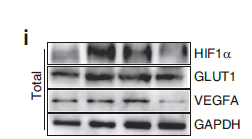
主要信息
Target
CENPR
Host Species
Rabbit
Reactivity
Human, Rat, Mouse,
Applications
WB, ELISA
MW
19kD (Observed)
Conjugate/Modification
Unmodified
货号: YN1582
规格
价格
货期
数量
200μL
¥3,780.00
现货
0
100μL
¥2,300.00
现货
0
40μL
¥960.00
现货
0
加入购物车


已收藏


收藏
详细信息
推荐稀释比
WB 1:500-2000; ELISA 1:5000-20000
组成
Liquid in PBS containing 50% glycerol, and 0.02% sodium azide.
特异性
CENPR Polyclonal Antibody detects endogenous levels of protein.
纯化工艺
The antibody was affinity-purified from rabbit antiserum by affinity-chromatography using epitope-specific immunogen.
储存
-15°C to -25°C/1 year(Do not lower than -25°C)
浓度
1 mg/ml
实测条带
19kD
修饰
Unmodified
克隆性
Polyclonal
同种型
IgG
相关产品
抗原&靶点信息
免疫原:
Synthesized peptide derived from human protein . at AA range: 10-90
展开内容
特异性:
CENPR Polyclonal Antibody detects endogenous levels of protein.
展开内容
基因名称:
ITGB3BP CENPR NRIF3
展开内容
蛋白名称:
Centromere protein R (CENP-R) (Beta-3-endonexin) (Integrin beta-3-binding protein) (Nuclear receptor-interacting factor 3)
展开内容
背景:
This gene encodes a transcriptional coregulator that binds to and enhances the activity of members of the nuclear receptor families, thyroid hormone receptors and retinoid X receptors. This protein also acts as a corepressor of NF-kappaB-dependent signaling. This protein induces apoptosis in breast cancer cells through a caspase 2-mediated signaling pathway. This protein is also a component of the centromere-specific histone H3 variant nucleosome associated complex (CENP-NAC) and may be involved in mitotic progression by recruiting the histone H3 variant CENP-A to the centromere. Alternate splicing results in multiple transcript variants. [provided by RefSeq, Sep 2011],
展开内容
功能:
Domain:Contains one Leu-Xaa-Xaa-Ile-Leu (LXXIL) motif, which is essential for the association with nuclear receptors.,Domain:Contains one Leu-Xaa-Xaa-Leu-Leu (LXXLL) motif, a motif known to be important for the association with nuclear receptors. Such motif, which is required for an efficient association with nuclear receptors, is however not essential.,Domain:The DD1 domain (also called RepD1 domain) mediates the corepressor function and is essential in the triggering of apoptosis.,Function:Transcription coregulator that can have both coactivator and corepressor functions. Isoform 1, but not other isoforms, is involved in the coactivation of nuclear receptors for retinoid X (RXRs) and thyroid hormone (TRs) in a ligand-dependent fashion. In contrast, it does not coactivate nuclear receptors for retinoic acid, vitamin D, progesterone receptor, nor glucocorticoid. Acts as a coactivator for estrogen receptor alpha. Acts as a transcriptional corepressor via its interaction with the NFKB1 NF-kappa-B subunit, possibly by interfering with the transactivation domain of NFKB1. Induces apoptosis in breast cancer cells, but not in other cancer cells, via a caspase-2 mediated pathway that involves mitochondrial membrane permeabilization but does not require other caspases. May also act as an inhibitor of cyclin A-associated kinase. Also acts a component of the CENPA-CAD (nucleosome distal) complex, a complex recruited to centromeres which is involved in assembly of kinetochore proteins, mitotic progression and chromosome segregation. May be involved in incorporation of newly synthesized CENPA into centromeres via its interaction with the CENPA-NAC complex.,induction:By estrogen.,subcellular location:Isoform 3 is predominantly nuclear and weakly cytoplasmic.,subunit:Homodimer; mediated by the coiled coil domain. Isoform 3, but not other isoforms, interacts with the cytoplasmic tail of integrin ITGB3. The relevance of the interaction with ITGB3 is however uncertain, since isoform 3 is mainly nuclear. Interacts with CCNA2 and MTA1. Interacts with NFKB1 NF-kappa-B subunit. Component of the CENPA-CAD complex, composed of CENPI, CENPK, CENPL, CENPO, CENPP, CENPQ, CENPR and CENPS. The CENPA-CAD complex interacts with the CENPA-NAC complex, at least composed of CENPA, CENPC, CENPH, CENPM, CENPN, CENPT and MLF1IP/CENPU.,tissue specificity:Widely expressed. Expressed in spleen, thymus, prostate, ovary, small intestine and white blood cells. Highly expressed in testis and colon. Isoform 4 is expressed in platelets, lymphocytes and granulocytes.,
展开内容
细胞定位:
[Isoform 1]: Nucleus. Chromosome, centromere. Chromosome, centromere, kinetochore.; [Isoform 2]: Nucleus.; [Isoform 3]: Nucleus. Cytoplasm. Isoform 3 is predominantly nuclear and weakly cytoplasmic.; [Isoform 4]: Cytoplasm.
展开内容
组织表达:
Widely expressed. Expressed in spleen, thymus, prostate, ovary, small intestine and white blood cells. Highly expressed in testis and colon. Isoform 4 is expressed in platelets, lymphocytes and granulocytes.
展开内容
文献引用({{totalcount}})
货号: YN1582
规格
价格
货期
数量
200μL
¥3,780.00
现货
0
100μL
¥2,300.00
现货
0
40μL
¥960.00
现货
0
加入购物车


已收藏


收藏
Recently Viewed Products
Clear allToggle night Mode
{{pinfoXq.title || ''}}
Catalog: {{pinfoXq.catalog || ''}}
Filter:
All
{{item.name}}
{{pinfo.title}}
-{{pinfo.catalog}}
主要信息
Target
{{pinfo.target}}
Reactivity
{{pinfo.react}}
Applications
{{pinfo.applicat}}
Conjugate/Modification
{{pinfo.coupling}}/{{pinfo.modific}}
MW (kDa)
{{pinfo.mwcalc}}
Host Species
{{pinfo.hostspec}}
Isotype
{{pinfo.isotype}}
产品 {{index}}/{{pcount}}
上一个产品
下一个产品
{{pvTitle}}
滚轮缩放图片
{{pvDescr}}




















